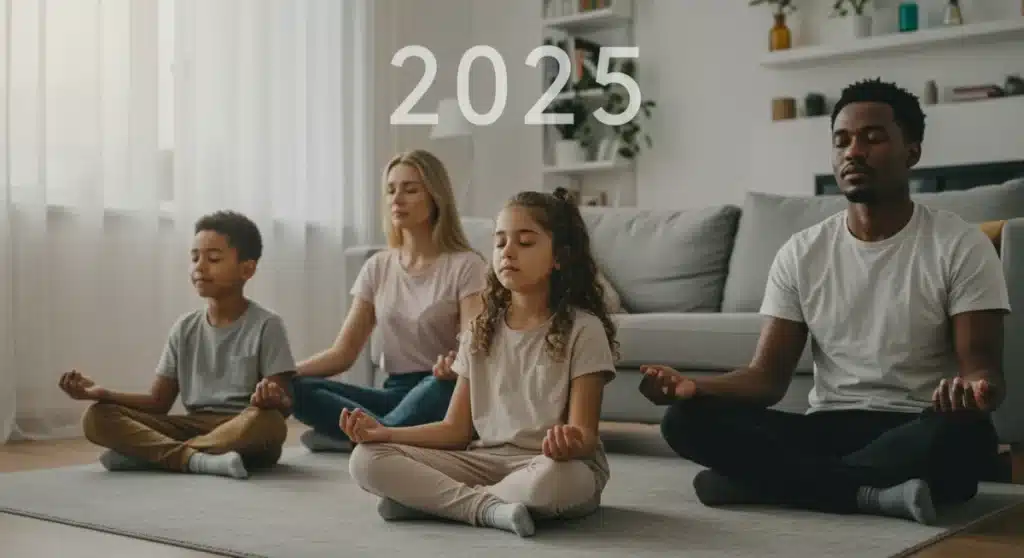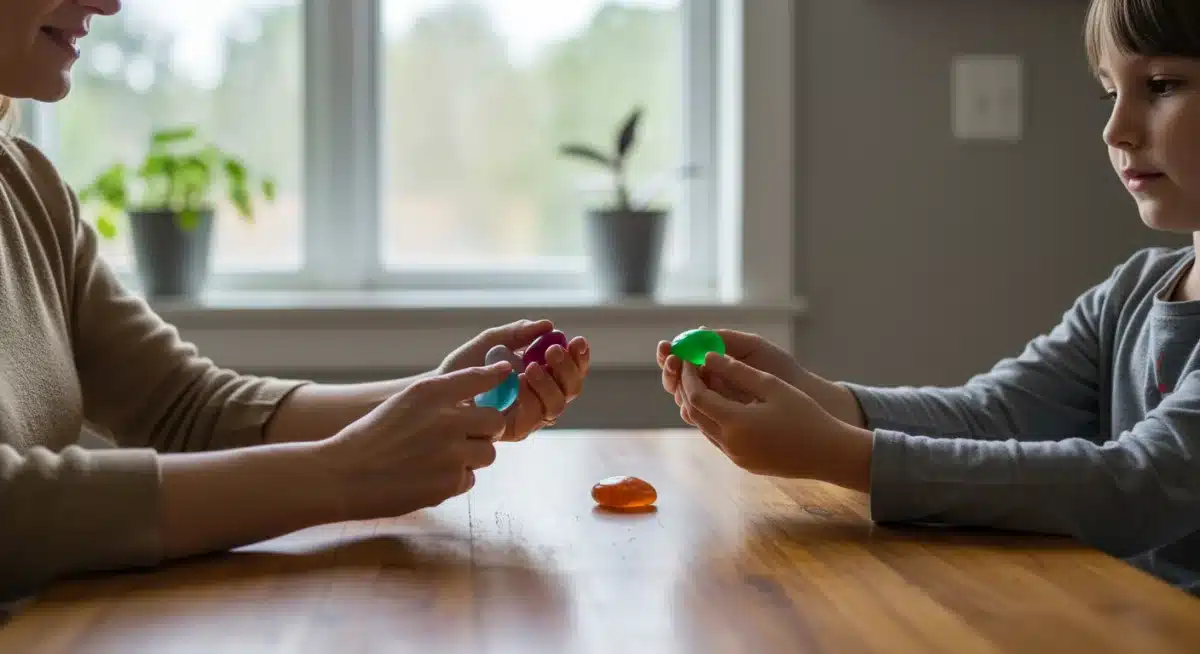Mindfulness for Modern Families: 4 Simple Daily Practices for 2025

Modern families are urgently seeking practical mindfulness strategies for 2025 to combat increasing daily stress and foster stronger emotional well-being, focusing on accessible, time-sensitive integration into busy schedules.
As of late 2024, the demand for practical, time-sensitive solutions to enhance family well-being continues to surge. Mindfulness for Modern Families: 4 Simple Daily Practices for 2025 offers immediate, actionable strategies designed to integrate calm and connection into even the busiest household routines. This report highlights key developments and practical applications for the upcoming year.
The Current Landscape: Why Mindfulness is Critical Now
The pace of modern family life has accelerated dramatically, fueled by digital distractions, demanding work schedules, and a constant influx of information. This environment often leaves families feeling overwhelmed and disconnected. Mindfulness, once considered a niche practice, is now recognized as a critical tool for navigating these complexities, offering a pathway to reduced stress and enhanced emotional regulation for both adults and children.
Recent studies, including a report from the American Psychological Association in October 2024, indicate a sustained rise in parental stress levels, directly impacting family dynamics. The need for accessible, science-backed interventions is paramount. Mindfulness practices provide a framework for families to pause, reconnect, and cultivate resilience, addressing the immediate challenges of digital overload and time scarcity.
Digital Detox and Mindful Moments
One primary concern for modern families is the pervasive influence of screens. Integrating mindful breaks from digital devices can significantly improve family interactions. These don’t require extensive planning, but rather intentional, short periods of disengagement.
- Scheduled Screen-Free Zones: Designate specific times or areas in the home where devices are put away, fostering uninterrupted interaction.
- Mindful Device Use: Encourage family members to reflect on their intentions before picking up a device, asking ‘Why am I looking at this now?’
- Digital Sunset: Implement a family-wide ‘digital sunset’ an hour before bedtime to improve sleep quality and promote evening connection.
Practice 1: The Mindful Minute Check-in
The Mindful Minute Check-in is a foundational practice designed for rapid integration into daily routines, even amidst chaos. This simple exercise involves pausing for 60 seconds to notice one’s breath, body sensations, and surrounding environment without judgment. It’s a quick reset button for individuals and can be easily adapted for family participation, fostering collective calm.
This practice, gaining significant traction in early 2025 wellness programs, emphasizes accessibility. It requires no special equipment or prior experience, making it ideal for busy parents and energetic children. The goal is not perfection, but consistent, brief moments of awareness that accumulate throughout the day, shifting the family’s overall emotional tone.
Implementing Mindful Breathing Together
A core component of the Mindful Minute is focused breathing. Teaching children and adults simple breathing exercises can be a powerful tool for stress reduction.
- Balloon Breath: Imagine your belly is a balloon, expanding on the inhale and deflating on the exhale.
- Five-Finger Breath: Trace your fingers with your other hand, inhaling up one finger and exhaling down the other.
- Counting Breaths: Inhale for four counts, hold for two, exhale for six.
Practice 2: Mindful Meals and Gratitude
Meal times often become rushed and distracted in modern households. Mindful Meals transform these daily necessities into opportunities for connection, presence, and gratitude. This practice involves paying full attention to the act of eating—the flavors, textures, and aromas—and appreciating the food and the company. It’s a deliberate effort to slow down and engage all senses, moving away from eating while multitasking.
This approach not only enhances digestive well-being but also cultivates a sense of appreciation and togetherness. By focusing on the present moment during meals, families can reduce conflict, improve communication, and strengthen their bonds. It’s a simple shift that yields profound benefits, turning routine into ritual.

Practice 3: The Family Gratitude Jar
Cultivating an attitude of gratitude has been consistently linked to increased happiness and resilience. The Family Gratitude Jar is a simple, tangible practice where family members write down things they are grateful for and place them in a designated jar. This can be done daily, weekly, or during specific moments of reflection, offering a physical representation of collective appreciation.
This practice fosters a positive family culture, encouraging members to actively seek out and acknowledge the good in their lives, even amidst challenges. Periodically, the family can gather to read the notes aloud, reinforcing positive emotions and shared experiences. This collective reflection builds empathy and strengthens family cohesion, providing a powerful antidote to negativity.
Making Gratitude a Daily Ritual
Integrating the gratitude jar effectively requires consistency and a fun approach. Make it a part of a routine, like dinner or bedtime.
- Decorate the Jar: Involve children in decorating the jar to make it feel special and personalized.
- Prompt Questions: Offer prompts if family members struggle with ideas, such as ‘What made you smile today?’ or ‘Who helped you today?’
- Regular Review: Schedule a monthly or quarterly ‘reading night’ to revisit the gratitude notes and celebrate shared blessings.
Practice 4: Mindful Movement Together
In an era dominated by sedentary lifestyles, incorporating mindful movement is crucial for both physical and mental health. This practice involves engaging in physical activities with full awareness, focusing on body sensations, breath, and the present moment rather than just the outcome. This can range from a family walk in nature to simple stretching or yoga poses, done together with intention.
Mindful movement is particularly effective for children, helping them develop body awareness, coordination, and emotional regulation. For families, it offers a shared activity that promotes physical health, reduces stress, and strengthens bonds without the pressure of competitive sports. It’s about enjoying the journey of movement, rather than just the destination.
Simple Ways to Introduce Family Mindful Movement
Starting small and making it enjoyable is key to successful integration of mindful movement into family life.
- Nature Walks: Take walks and encourage everyone to notice sounds, smells, and sights.
- Family Yoga: Follow a simple online yoga video designed for families, focusing on breath and gentle stretches.
- Conscious Play: Engage in active play, like dancing or playing catch, with full attention and presence.
Overcoming Obstacles: Consistency and Adaptability
Implementing new practices in a busy family environment often faces hurdles, primarily time constraints and resistance from family members. The key to success lies in consistency, even if it’s for very short durations, and adaptability. These mindfulness practices are designed to be flexible, allowing families to tailor them to their unique schedules and preferences. Starting small and gradually increasing engagement is more effective than attempting drastic changes.
It’s important to frame these practices not as chores, but as opportunities for growth and connection. Parents can model the behavior, demonstrating the benefits of mindfulness through their own calm and presence. Open communication about the ‘why’ behind these practices can also foster greater buy-in from children and partners, creating a supportive environment for collective well-being.
| Key Practice | Brief Description |
|---|---|
| Mindful Minute Check-in | A 60-second pause to focus on breath and body, easily integrated throughout the day for quick resets. |
| Mindful Meals | Eating with full sensory awareness and gratitude, transforming meal times into connecting moments. |
| Family Gratitude Jar | Collect daily notes of appreciation in a jar, fostering a positive family culture and collective reflection. |
| Mindful Movement | Engaging in physical activity with full awareness, promoting physical health and stress reduction. |
Frequently Asked Questions About Family Mindfulness
Introduce mindfulness through playful activities like ‘listening games’ or ‘smell detective.’ Keep sessions very short, perhaps 30 seconds, and use concrete examples tied to their senses. Storytelling and simple breathing exercises can also be highly effective for engaging young minds.
Integrate mindfulness into existing routines rather than creating new ones. A ‘Mindful Minute’ during breakfast, a few conscious breaths while waiting in line, or a moment of gratitude before sleep can make a significant difference. Consistency in short bursts is more impactful than infrequent long sessions.
Mindful eating fosters improved digestion, reduces overeating, and enhances appreciation for food. For families, it creates a calmer mealtime environment, encourages better communication, and strengthens bonds by transforming a routine activity into a shared, present-moment experience. It also helps children develop a healthier relationship with food.
Yes, mindfulness can teach children to pause before reacting, recognize their emotions, and respond more thoughtfully. Practices like conscious breathing or a ‘calm-down corner’ can provide tools for self-regulation during conflicts, potentially reducing intensity and fostering more empathetic resolutions between siblings.
Numerous free resources are available, including guided meditations on YouTube designed for children and families, apps like Insight Timer offering free content, and websites with downloadable mindfulness exercises. Public libraries often have books and resources on family mindfulness, providing accessible starting points for all.
Looking Ahead: Sustaining Family Well-being in 2025
The implementation of these four simple daily practices represents a proactive step for modern families entering 2025. The ongoing challenges of a fast-paced world necessitate adaptable and accessible wellness strategies. We anticipate continued emphasis on integrating mental well-being into daily routines, with a growing recognition of mindfulness as a foundational skill for resilience. Further research and community programs are expected to expand, providing even more tailored support for diverse family structures. The focus remains on practical, sustainable solutions that empower families to thrive amidst evolving societal pressures.





